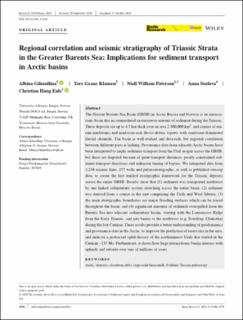| dc.description.abstract | The Greater Barents Sea Basin (GBSB) in Arctic Russia and Norway is an intracratonic basin that accommodated an enormous amount of sediment during the Triassic. These deposits are up to 4.5 km thick over an area 2,500,000 km2, and consist of marine mudstones and mudstone-rich fluvio-deltaic topsets with sandstone-dominated fluvial channels. The basin is well-studied and data-rich, but regional correlation between different parts is lacking. Provenance data from adjacent Arctic basins have been interpreted to imply sediment transport from the Ural orogen across the GBSB, but these are disputed because of great transport distances, poorly constrained sediment-transport directions and unknown timing of bypass. We integrated data from 3,238 seismic lines, 257 wells and palynostratigraphy, as well as published outcrop data, to create the first unified stratigraphic framework for the Triassic deposits across the entire GBSB. Results show that (1) sediment was transported northwest by one linked sedimentary system stretching across the entire basin; (2) sediment was derived from a source in the east comprising the Urals and West Siberia; (3) the main stratigraphic boundaries are major flooding surfaces which can be traced throughout the basin; and (4) significant amounts of sediment overspilled from the Barents Sea into adjacent sedimentary basins, starting with the Lomonosov Ridge from the Early Triassic, and into basins to the northwest (e.g. Sverdrup, Chukotka) during the late Carnian. These results provide a better understanding of geodynamics and provenance data in the Arctic, to improve the prediction of reservoirs in the area, and indicate a protracted uplift-history of the northernmost Urals that started in the Carnian ~237 Ma. Furthermore, it shows how large intracratonic basins interact with uplands and subside over tens of millions of years. | en_US |

